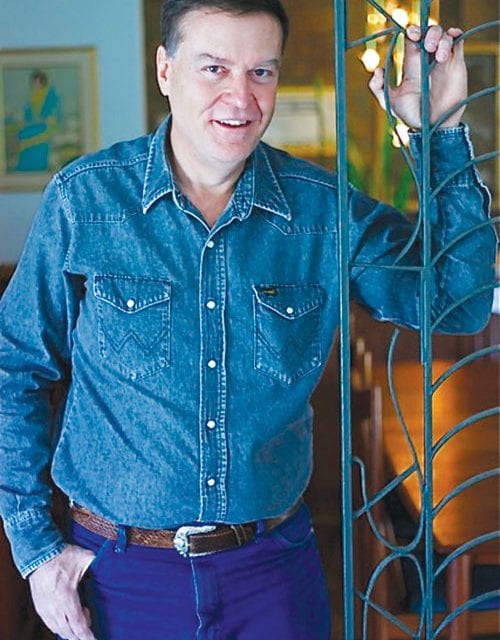Gay antiques collector Max Tibbits had good taste before you did

CONTEMPORARY STYLE | Tibbits has been obsessed with mid-century modern furnishings for decades. (Photo courtesy D’Ette Cole)
When Max Tibbits was growing up in the 1960s, his house was in “kind of isolated” part of Central Texas. “There were not a lot of kids in the neighborhood,” he says in a recent phone interview.
Tibbits’ mother designed and built houses, so what the family did have lying around the house were a lot of old copies of periodicals from the National Association of Homebuilders and Architectural Forum — not exactly traditional childhood reading.
Like many gay kids starved to embrace creativity, Tibbits loved poring over them.
“I would read those magazines to keep myself company,” he says.
“At first I just liked the advertisements, and then I liked the articles.”
Tibbits went on to study architecture at Texas A&M, but detoured, slowly, into a different but related arena: Antiques. He now owns and sells a vast, beautifully edited collection of mid-century furniture.
Tibbits will be on hand with some of his collection this weekend at the Fort Worth Show of Antique and Arts (formerly the Dolly Johnson Show), celebrating its 50th year. Last year, Tibbits sold out all but two piece of his entire stock of mid-century wares.
While these days mid-century pieces are almost de rigueur for anyone with an eye for design, that wasn’t always that case; Tibbits got an interest in it early on. While at A&M, his grandmother was re-doing an old room and planned to give away all the furniture in it.
“I said, ‘No! I want it!’” Tibbits laughs. He ended up with a room full of furniture others considered outdated; now they are classic collectibles. And the collection has grown ever crowded since.
“I always thought it was cool, and I started so many years ago when no one else was interested in it, I was hoarding it for a while,” he says. “People would tease me about it.”
 The unenlightened teasers probably wish they had held their tongues. Tibbits now owns a warehouse full of beauts — Eames chairs, Florence Knoll credenzas and other pieces featuring the clean, unadorned, deceptively simple looking designs that mark the period. But the beauty of the furniture isn’t just in its aesthetic.
The unenlightened teasers probably wish they had held their tongues. Tibbits now owns a warehouse full of beauts — Eames chairs, Florence Knoll credenzas and other pieces featuring the clean, unadorned, deceptively simple looking designs that mark the period. But the beauty of the furniture isn’t just in its aesthetic.
“It feels like it is part of a time when the U.S. was at its sort of zenith of creativity and power,” he says. “Even though it was a really repressive period too, people became very creative in the places that they could.”
It’s a thoughtful way of looking at what otherwise might just be considered either a purely functional aspect of life, or a purely fashionable one. This furniture means something to Tibbits, a fact reflected in his careful editing of what he chooses and what he sells.
Once packed, his warehouse is beginning to clear out a little as his inventory gets more and more popular. As his search for new pieces goes one, Tibbits says, his love of mid-century pieces never wanes. He pinpoints one aspect that continues his excitement:
“Modern design was so creative, there’s an energy to it,” he says. “It wasn’t like some rehashing of something that had been done before.”
— Jonanna Widner
This article appeared in the Dallas Voice print edition March 8, 2013.

